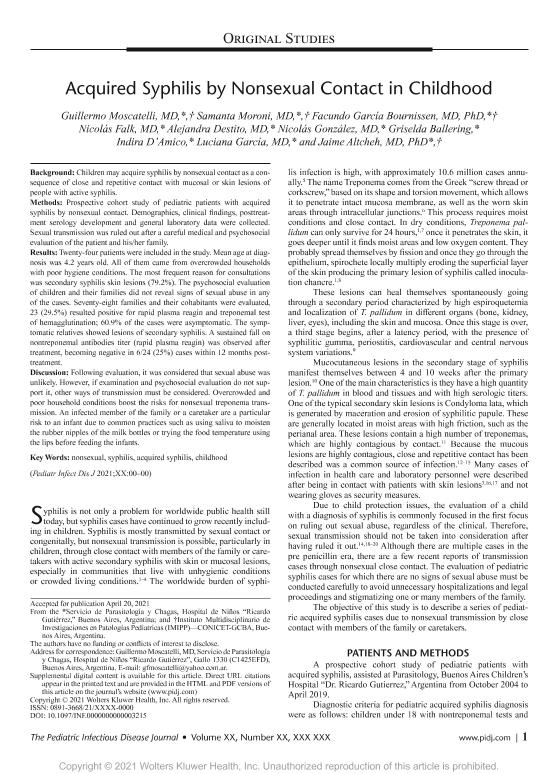Artículo
Acquired Syphilis by Nonsexual Contact in Childhood
Moscatelli, Guillermo ; Moroni, Samanta; García Bournissen, Facundo
; Moroni, Samanta; García Bournissen, Facundo ; Falk, Nicolás Ariel; Destito, Alejandra; González, Nicolás; Ballering, Griselda Edith; D'Amico, Indira; García, Luciana Noemí
; Falk, Nicolás Ariel; Destito, Alejandra; González, Nicolás; Ballering, Griselda Edith; D'Amico, Indira; García, Luciana Noemí ; Altcheh, Jaime Marcelo
; Altcheh, Jaime Marcelo
 ; Moroni, Samanta; García Bournissen, Facundo
; Moroni, Samanta; García Bournissen, Facundo ; Falk, Nicolás Ariel; Destito, Alejandra; González, Nicolás; Ballering, Griselda Edith; D'Amico, Indira; García, Luciana Noemí
; Falk, Nicolás Ariel; Destito, Alejandra; González, Nicolás; Ballering, Griselda Edith; D'Amico, Indira; García, Luciana Noemí ; Altcheh, Jaime Marcelo
; Altcheh, Jaime Marcelo
Fecha de publicación:
04/2021
Editorial:
Lippincott Williams
Revista:
Pediatric Infectious Disease Journal
ISSN:
0891-3668
Idioma:
Inglés
Tipo de recurso:
Artículo publicado
Clasificación temática:
Resumen
Background: Children may acquire syphilis by nonsexual contact as a consequence of close and repetitive contact with mucosal or skin lesions of people with active syphilis. Methods: Prospective cohort study of pediatric patients with acquired syphilis by nonsexual contact. Demographics, clinical findings, posttreatment serology development and general laboratory data were collected. Sexual transmission was ruled out after a careful medical and psychosocial evaluation of the patient and his/her family. Results: Twenty-four patients were included in the study. Mean age at diagnosis was 4.2 years old. All of them came from overcrowded households with poor hygiene conditions. The most frequent reason for consultations was secondary syphilis skin lesions (79.2%). The psychosocial evaluation of children and their families did not reveal signs of sexual abuse in any of the cases. Seventy-eight families and their cohabitants were evaluated, 23 (29.5%) resulted positive for rapid plasma reagin and treponemal test of hemagglutination; 60.9% of the cases were asymptomatic. The symptomatic relatives showed lesions of secondary syphilis. A sustained fall on nontreponemal antibodies titer (rapid plasma reagin) was observed after treatment, becoming negative in 6/24 (25%) cases within 12 months posttreatment. Discussion: Following evaluation, it was considered that sexual abuse was unlikely. However, if examination and psychosocial evaluation do not support it, other ways of transmission must be considered. Overcrowded and poor household conditions boost the risks for nonsexual treponema transmission. An infected member of the family or a caretaker are a particular risk to an infant due to common practices such as using saliva to moisten the rubber nipples of the milk bottles or trying the food temperature using the lips before feeding the infants.
Palabras clave:
ACQUIRED SYPHILIS
,
CHILDHOOD
,
NONSEXUAL
,
SYPHILIS
Archivos asociados
Licencia
Identificadores
Colecciones
Articulos(IMIPP)
Articulos de INSTITUTO MULTIDISCIPLINARIO DE INVESTIGACIONES EN PATOLOGIAS PEDIATRICAS
Articulos de INSTITUTO MULTIDISCIPLINARIO DE INVESTIGACIONES EN PATOLOGIAS PEDIATRICAS
Citación
Moscatelli, Guillermo; Moroni, Samanta; García Bournissen, Facundo; Falk, Nicolás Ariel; Destito, Alejandra; et al.; Acquired Syphilis by Nonsexual Contact in Childhood; Lippincott Williams; Pediatric Infectious Disease Journal; 4-2021; 892-898
Compartir
Altmétricas



